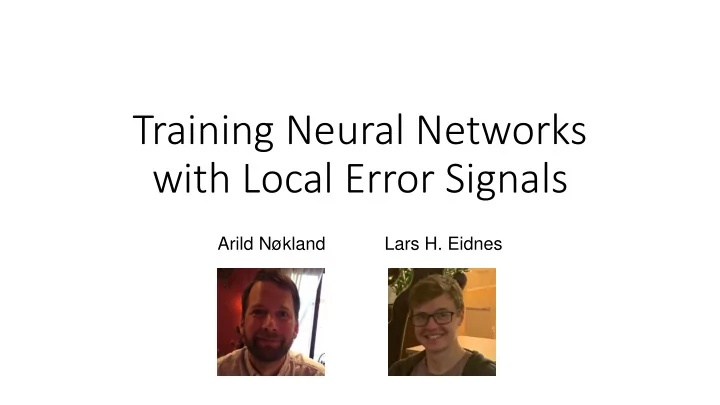

Training Neural Networks with Local Error Signals Arild Nøkland Lars H. Eidnes
Local learning • Typically we train neural networks by backpropagating errors from the loss function and back through the layers. • Hard to explain how the brain could do this. • Backward locking, weight symmetry, other problems • Massive practical benefits if you could avoid this. • Don't have to keep activations in memory • Can parallelize easily. Put each layer on its own GPU, train all at the same time.
Training each layer on its own works! Results on more datasets later.
The approach Train each layer with two sub-networks, each with its own loss function
Similarity matching loss Intuition: Want things from the same class to have similar representations. Measure similarity with a matrix of cosine similarities.
Results
Results
Results
Optimization vs generalization • Back-prop has fastest & lowest drop in training error • Local learning is competitive with back-prop in terms of test error • Local learning is a good regularizer • But: Both pred and sim- losses help optimization in a complementary way.
Sim-loss + global backprop
Results, back-prop free version • Still have 1-step backprop. To remove it: • Remove the conv2d before the sim-loss • Use Feedback Alignment [Lillicrap et al, 2014] through linear before the pred-loss • Also: Use a random projection of the labels
Summary • We train each layer on its own, without global backprop • We use two loss functions • Standard cross entropy loss • A similarity matching loss • Squared error on similarity matrices • Wants similar activations for things of the same class • Works well on VGG-like networks
Intriguing questions • We’ve just prodded the space of local loss functions, and stumbled across something that helps a lot. Is there more to be found in this space? • Can we better understand how layers interact when they are trained on their own? I.e. why does this work? • Does something like this happen in the brain?
Recommend
More recommend